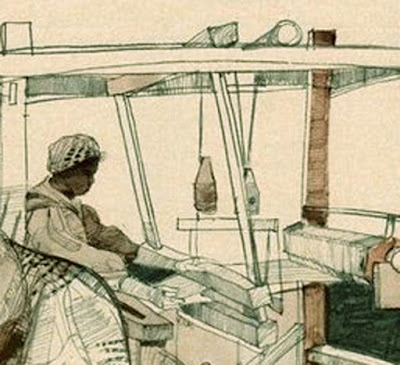Mary Wallace Jones and George Noble Jones were rarely at El Destino. They spent most of their time at their Georgia houses and plantations and during the fever seasons when malaria and yellow fever raged they spent summers in their Newport, Rhode Island home.
George was rich, Mary was richer and it seems to be through her family that Venus and her brother Aberdeen were brought from Georgia to El Destino (the word also means Destination). Venus was probably born at Silk Hope on the Little Ogeechee River near Savannah, a colonial Georgia plantation owned by the Habersham & Savage family.
In April, 1847 Venus was ill, in the journal notes "confind" to the sick house. She may have been delivering a baby, an event often described as a "confinement," but several other women were "confind" that month too and it may be that they had to all-too-common, contagious infection. Venus remained confined for over three weeks from April 4 to the 27th when she returned to her usual task of spinning.
Venus is recorded as having at least three children in 1847: Jack, Julia and Peggy; by 1854 she'd added Hariat and Amey. Her husband was likely the man named Pleasant, who worked in the blacksmith shop and on the cotton wagons. On April 30, 1852 Overseer John Evans wrote George Jones: "I reckon that you have heard of the Death of Pleasant."
Ouch! We hadn't heard.
August of 1854 was a hot one and the overseer D. N. Moxley did not know or care about heat stroke. Four women fainted in the fields and to punish them (or foolishly try to make up for lost work) he required extra labor in the fall.
In October the women rebelled and ran away to Tallahassee seeking refuge with Tom Blackledge, father of one of the runaways. His wife Delia (some spelled it Dealier or Dealer) was also enslaved at the Jones's place but Tom worked in town. Tom's employer Dr. Davis wrote a letter backing up the women's protests. They were jailed in Tallahassee for running away and it cost Moxley "about $13 to get them out" .
During this time Moxley came upon Venus on the road to town. He caught her and tried to strong arm her into the plantation's lock-up but she broke away. He grabbed her again and and her brother Aberdeen defended her by threatening Moxley with an axe. The African-American foreman Prince Habersham fortunately calmed everyone down.
There were "bastings" from Moxley for everyone involved. He also forbid Tom Blackledge to visit his family at the plantation and curtailed any visits to town by anybody.
Martha - Weaver Prolapsus Uteri - 32
Whatley - Plough boy - 14
Minie - hoes, ¼ hand - 11
Mary - Water carrier - 10
Daphne - 9
Ben - 7
Stephen - 6
Venus - 4
Ellen - 2
Aberdeen was 36 in May, 1865. He'd named a four-year old for his sister. His poor wife Martha, also a weaver, is described as unable to work, having a prolapsed uterus after eight children born from the time she was about 18. Aberdeen and family continued to live in the area as a tenant farmer.
But where is Venus? We can certainly hope she lived to see emancipation.
More on these Floridians:
See an online version of a 1927 study of the records by Ulrich B. Phillips & James David Glunt, "Florida Plantation Records from the papers of George Noble Jones" https://babel.hathitrust.org/cgi/pt?id=mdp.39015011232298&view=1up&seq=5
Related publications:
Slavery & Plantation Growth in Antebellum Florida 1821-1860 by Julia Floyd Smith:https://ufdcimages.uflib.ufl.edu/AA/00/06/19/96/00001/9781947372627_Smith.pdf
"Slave Cloth and Clothing Slaves: Craftsmanship, Commerce, and Industry" by Madelyn Shaw:https://www.mesdajournal.org/2012/slave-cloth-clothing-slaves-craftsmanship-commerce-industry/
"Clothes for the People, Slave Clothing in Early Virginia" by Linda Baumgarten:https://research.colonialwilliamsburg.org/DigitalLibrary/view/index.cfm?doc=ResearchReports%5CRR0409.xml
























No comments:
Post a Comment